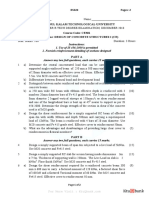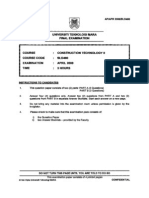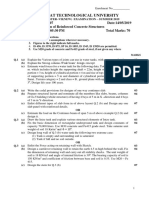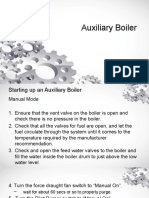Constec
Constec
Uploaded by
Kamal Idris Switch-onCopyright:
Available Formats
Constec
Constec
Uploaded by
Kamal Idris Switch-onCopyright
Available Formats
Share this document
Did you find this document useful?
Is this content inappropriate?
Copyright:
Available Formats
Constec
Constec
Uploaded by
Kamal Idris Switch-onCopyright:
Available Formats
CONFIDENTIAL AP/APR 2009/JSB201/ARK451
UNIVERSITl TEKNOLOGI MARA
FINAL EXAMINATION
COURSE : CONSTRUCTION TECHNOLOGY I
COURSE CODE : JSB201/ARK451
EXAMINATION : APRIL 2009
TIME : 3 HOURS
INSTRUCTIONS TO CANDIDATES
1. This question paper consists of five (5) questions.
2 Answer four (4) questions only in the Answer booklet. Start each answer on a new page.
3. Do not bring any material into the examination room unless permission is given by the
invigilator.
Please check to make sure that this examination pack consists of:
i) the Question Paper
ii) an Answer Booklet - provided by the Faculty
DO NOT TURN THIS PAGE UNTIL YOU ARE TOLD TO DO SO
This examination paper consists of 4 printed pages
> Hak Cipta Universlti Teknologl MARA CONFIDENTIAL
CONFIDENTIAL 2 AP/APR 2009/JSB201/ARK451
Answer FOUR (4) questions only
QUESTION 1
a) With regards to materials used in domestic buildings of load-bearing wall construction,
answer the following:
i) List out five (5) common materials used in the construction.
(5 marks)
ii) Describe the characteristics and properties for each of the materials described
above.
(10 marks)
b) Discuss the works undertaken by following building trades:
i) Concreter
ii) Bricklayer
Hi) Carpenter
iv) Bar bender
v) Plasterer
(10 marks)
QUESTION 2
Load bearing wall construction is one of the common construction methods used in
constructing a small scale building. With regards to load-bearing cavity wall construction
system, answer the following questions:
a) Briefly describe the cavity wall.
(4 marks)
b) With the aid of sketches, illustrate two (2) common types of metal wall ties used in load-
bearing cavity wall construction.
(5 marks)
c) With the aid of a fully annotated diagram, draw the elevation of wall tie spacing setting
out. The illustration should illustrate the following information: position of wall tie and
dimension between metal wall tie within brick layer construction.
(8 marks)
d) With the aid of sketches, draw a typical detail of cavity wall construction. The Illustration
should illustrate the typical strip foundation, part of floor and vertical wall construction.
(8 marks)
© Hak Cipta Universitf Teknologi MARA CONFIDENTIAL
CONFIDENTIAL 3 AH/APR 2009/JSB201/ARK451
QUESTION 3
With regards to suspended ground floor construction for load-bearing walls, answer the
following:
a) List out two (2) advantages.
(5 marks)
b) List out two (2) disadvantages.
(5 marks)
c) With the aid of 3 dimensional sketches and annotations, draw a typical detail of a
suspended ground floor. The Illustration should illustrate the typical strip or raft
foundation, part of floor and vertical wall construction.
(15 marks)
QUESTION 4
With regards to steel portal frame system that is commonly used for factories and
warehouse buildings, answer the following questions:
a) List out five (5) main building components that are commonly used.
(5 marks)
b) Explain why steel portal frame is commonly used in the construction of the above
building types.
(5 marks)
c) With the aid of a fully annotated diagram, illustrate in three dimension, a small scale steel
portal frame structure of a factory or warehouse.
(15 marks)
QUESTION i
With regards to the drawings in Appendix 1 of a single storey building of non-cavity load-
bearing wall construction system, answer the following questions:
a) Draw a complete 2 dimensional construction detail at 'A'. The detail should illustrate the
following:
i) Floor construction: 100mm structural floor slab with min. 50mm floor screed and min.
8mm thick floor tiles finishes, damp proof membrane (DPM), damp proof course
(DPC), 50mm thick sand bedding and min. 150mm thick hardcore.
ii) Standard non-cavity load-bearing wall construction with 13mm thick internal
plastering.
iii) 300mm thick strip foundation.
© Hak Cipta Unlversltl Teknolog! MARA CONFIDENTIAL
CONFIDENTIAL 4 AP/APR 2009/JSB201/ARK451
iv) Apron and surface drainage construction: min. 150mm thick hardcore with 50mm
thick sand bedding, 100mm thick concrete slab with 50mm floor screed and finishes,
250mm diameter half round precast concrete drain.
(10 marks)
b) Draw a complete 2 dimensional construction detail at 'B'. The detail should illustrate the
following:
i) Standard non-cavity load-bearing wall construction: 50x100mm thick hardwood wall
plate, metal dowel at 600mm centre-to-centre, internal and external wall finishes to
be 13mm thick plaster.
ii) Roof structure: standard 50x150mm hardwood truss at 600mm centre-to-centre,
single layer of aluminum heat reflector, 50x50mm hardwood batten at 300mm centre-
to-centre, 20x220mm thick hardwood fascia board, standard concrete roof tiles.
iii) Exposed type gutter and rain water downpipe with fixing.
iv) Ceiling: 50x50mm hardwood spacer, 50x50mm hardwood joist, single layer plaster
board with skim coat, cornice.
(15 marks)
END OF QUESTION PAPER
© Hak Cipta Universiti Teknologi MARA CONFIDENTIAL
You might also like
- Reinforced Concrete Buildings: Behavior and DesignFrom EverandReinforced Concrete Buildings: Behavior and DesignRating: 5 out of 5 stars5/5 (1)
- BO039M1920M DatasheetDocument21 pagesBO039M1920M DatasheetJohn LyalNo ratings yet
- Faculty - Architecture, Planning, and Surveying - 2023 - Session 1 - Degree - Aaa451Document4 pagesFaculty - Architecture, Planning, and Surveying - 2023 - Session 1 - Degree - Aaa451Aisyah NursarahNo ratings yet
- Ebc 3105 Construction Technology IDocument3 pagesEbc 3105 Construction Technology IDante MutzNo ratings yet
- AQS2104200910 Building Construction IIDocument2 pagesAQS2104200910 Building Construction IISicelo MlopoNo ratings yet
- Construction TechnologyDocument3 pagesConstruction Technologyisharaprabhath11No ratings yet
- 2017 December CE301-A Design of Concrete Structures I - Ktu QbankDocument2 pages2017 December CE301-A Design of Concrete Structures I - Ktu QbankAa AaNo ratings yet
- Structural MasonryDocument4 pagesStructural Masonryy mugambiNo ratings yet
- Faculty - Architecture, Planning, and Surveying - 2022 - Session 2 - Degree - Aaa451Document3 pagesFaculty - Architecture, Planning, and Surveying - 2022 - Session 2 - Degree - Aaa451Aisyah NursarahNo ratings yet
- 2019 Dec. CE301-E - Ktu QbankDocument2 pages2019 Dec. CE301-E - Ktu QbankGenNo ratings yet
- Faculty - Architecture, Planning, and Surveying - 2022 - Session 1 - Diploma - DQS152Document3 pagesFaculty - Architecture, Planning, and Surveying - 2022 - Session 1 - Diploma - DQS152joniemamanNo ratings yet
- Design of Concrete Structures - I Question PaperDocument3 pagesDesign of Concrete Structures - I Question PaperSourav Sil50% (2)
- Ice-502-Ce-502 - FinalDocument2 pagesIce-502-Ce-502 - Finalarjunv_14No ratings yet
- H Building-Construction All 2009Document12 pagesH Building-Construction All 2009yrdgcgf5664No ratings yet
- Universiti Tun Hussein Onn Malaysia: ConfidentialDocument8 pagesUniversiti Tun Hussein Onn Malaysia: ConfidentialAshyra JamilNo ratings yet
- External Mocks Paper 3Document3 pagesExternal Mocks Paper 3lumbuyejonathan7No ratings yet
- Construction Technology EXAMDocument3 pagesConstruction Technology EXAMSamuelNo ratings yet
- DQS252 - QuestionDocument3 pagesDQS252 - Question2024545171No ratings yet
- CIV 3105 Construction Technology Exam 2021-Section BDocument2 pagesCIV 3105 Construction Technology Exam 2021-Section BOdiit StephenNo ratings yet
- Final Paper CE4012 - July 2023Document6 pagesFinal Paper CE4012 - July 2023wanasinghebhagya20No ratings yet
- Aba 2206 Building Technology IDocument2 pagesAba 2206 Building Technology IDave OdiwuorNo ratings yet
- Final Exam RC2 S1 - 20192020 - Soalan - v3 PDFDocument7 pagesFinal Exam RC2 S1 - 20192020 - Soalan - v3 PDFAshyra JamilNo ratings yet
- Limerick Institute of Technology Institiúid Teicneolaíochta Luimnigh Summer Examinations 2005Document5 pagesLimerick Institute of Technology Institiúid Teicneolaíochta Luimnigh Summer Examinations 2005Michael WallNo ratings yet
- Cet303 Dcs Dec 2022Document2 pagesCet303 Dcs Dec 2022kichuchristy411No ratings yet
- 2020-10-09SupplementaryCE301CE301-F - Ktu QbankDocument2 pages2020-10-09SupplementaryCE301CE301-F - Ktu QbankGenNo ratings yet
- Abpl30046 S1 180052 4176Document12 pagesAbpl30046 S1 180052 4176Amir YacoubNo ratings yet
- 2018 0 PDFDocument47 pages2018 0 PDFTanaya ChiplunkarNo ratings yet
- CE 502 5th Sem 2012 13 Concrete Struct IDocument2 pagesCE 502 5th Sem 2012 13 Concrete Struct Iarjunv_14No ratings yet
- Construction Technology & Materials-VIII: B.Arch. Tenth Semester (C.B.S.)Document12 pagesConstruction Technology & Materials-VIII: B.Arch. Tenth Semester (C.B.S.)Jatin TilwaniNo ratings yet
- 15arc7 2Document2 pages15arc7 2sanamNo ratings yet
- RAR803Document1 pageRAR803ar.arjung098No ratings yet
- Ol LC ConstDocument4 pagesOl LC ConstNicholas TierneyNo ratings yet
- Btech Ce 6 Sem Design of Concrete Structures Kce601 2022Document2 pagesBtech Ce 6 Sem Design of Concrete Structures Kce601 2022Omair Abdullah 15 CENo ratings yet
- AAR3108200212 Building Construction VDocument1 pageAAR3108200212 Building Construction VMacdonald MashawiNo ratings yet
- TK/KW/15 - 7797 Sixth Semester B. Architecture Examination: Construction - V Paper - VDocument2 pagesTK/KW/15 - 7797 Sixth Semester B. Architecture Examination: Construction - V Paper - VShraddha 08No ratings yet
- H Building-Construction All 2010Document12 pagesH Building-Construction All 2010yrdgcgf5664No ratings yet
- Question Paper Code:: Reg. No.Document2 pagesQuestion Paper Code:: Reg. No.raghavendran mNo ratings yet
- Individual Assignment 2 (Q)Document1 pageIndividual Assignment 2 (Q)vanessalau0410No ratings yet
- 2018 Dec. CE301-C - Ktu QbankDocument2 pages2018 Dec. CE301-C - Ktu QbankAa AaNo ratings yet
- Advanced Building Construction Technology - NDQS - 201Document2 pagesAdvanced Building Construction Technology - NDQS - 201Mohamed ThabithNo ratings yet
- BFC 21002 Jan12Document7 pagesBFC 21002 Jan12Nik AliffNo ratings yet
- A E1106 Pages: 2: Answer Any Two Full Questions, Each Carries 15 MarksDocument2 pagesA E1106 Pages: 2: Answer Any Two Full Questions, Each Carries 15 MarksGenNo ratings yet
- M09 - Building - Technology - CRADocument2 pagesM09 - Building - Technology - CRAjaanujaanu851No ratings yet
- EAR 2106 BUILDING TECHNOLOGY I Paper 1Document2 pagesEAR 2106 BUILDING TECHNOLOGY I Paper 1fityzgaulles miyiendaNo ratings yet
- T.Y. B.Arch.: Time: 3 Hours) (Max. Marks: 100 Instructions To The CandidatesDocument32 pagesT.Y. B.Arch.: Time: 3 Hours) (Max. Marks: 100 Instructions To The Candidateskaran9027No ratings yet
- X96171 (ST9006) Prefab StructDocument2 pagesX96171 (ST9006) Prefab StructSHANMUGARAJ MADASAMYNo ratings yet
- Building Construct PDFDocument10 pagesBuilding Construct PDFchristableNo ratings yet
- DRCSDocument2 pagesDRCSMorya RonakNo ratings yet
- Zeal Polytechnic, Pune.: Third Year (Ty) Diploma in Civil Engineering Scheme: I Semester: VDocument31 pagesZeal Polytechnic, Pune.: Third Year (Ty) Diploma in Civil Engineering Scheme: I Semester: Vpratikshapawar66440No ratings yet
- Diploma Board Examination - December 2020Document2 pagesDiploma Board Examination - December 2020iyappan619No ratings yet
- Construction Studies: Theory - Higher LevelDocument8 pagesConstruction Studies: Theory - Higher Levelombuilder92No ratings yet
- AAR2102200705 Building Construction IIDocument1 pageAAR2102200705 Building Construction IIJunior GwizaNo ratings yet
- Excel Engineering College, Komarapalayam: (Autonomous)Document3 pagesExcel Engineering College, Komarapalayam: (Autonomous)mythilispd_355305156100% (1)
- General Building and Construction IDocument2 pagesGeneral Building and Construction Ikipkuruienock38No ratings yet
- March 18 2009Document90 pagesMarch 18 2009api-26343009No ratings yet
- Universiti Teknologi Mara Final Examination: Confidential AP/APR 2009/BLD460Document4 pagesUniversiti Teknologi Mara Final Examination: Confidential AP/APR 2009/BLD460Meor SyahmiNo ratings yet
- All PDFDocument12 pagesAll PDFHeta PanchalNo ratings yet
- Ce402 2014 05Document5 pagesCe402 2014 05Daryl ChidengaNo ratings yet
- 2011 ct2Document2 pages2011 ct2Anonymous BoP7nnBNo ratings yet
- B.arch (2008 Pattern)Document54 pagesB.arch (2008 Pattern)koduruNo ratings yet
- Durability Design of Concrete Structures: Phenomena, Modeling, and PracticeFrom EverandDurability Design of Concrete Structures: Phenomena, Modeling, and PracticeNo ratings yet
- Software Requirements Specification For: COMSATS University Islamabad, Park Road, Chak Shahzad, Islamabad PakistanDocument44 pagesSoftware Requirements Specification For: COMSATS University Islamabad, Park Road, Chak Shahzad, Islamabad PakistanaddiNo ratings yet
- Oil Retention and Pressure Drop in Horizontal and Vertical SuctioDocument9 pagesOil Retention and Pressure Drop in Horizontal and Vertical SuctioBehnam AshouriNo ratings yet
- Physics Report Total Internal Reflection - EditedDocument10 pagesPhysics Report Total Internal Reflection - EditedJASMSJS SkskdjNo ratings yet
- Pengolahan Data Pompa SentrifugalDocument7 pagesPengolahan Data Pompa SentrifugalAnnisah MardiyyahNo ratings yet
- Rate of Reaction - TDocument8 pagesRate of Reaction - Tpanda152505No ratings yet
- Practice Midterm 03-SolutionsDocument7 pagesPractice Midterm 03-SolutionsElizabeth DouglasNo ratings yet
- K.Natarajan: Siemens LimitedDocument3 pagesK.Natarajan: Siemens LimitedNivetha VenkateswaranNo ratings yet
- Christopher AbabanDocument2 pagesChristopher AbabanRana Ahsan AliNo ratings yet
- Rti14 PDFDocument18 pagesRti14 PDFAbhishek KumarNo ratings yet
- Specular Showdown in The Wild West - Self ShadowDocument9 pagesSpecular Showdown in The Wild West - Self Shadowthi minh phuong nguyenNo ratings yet
- Tabel ASTM 53 PDFDocument32 pagesTabel ASTM 53 PDFsetiawan100% (1)
- Piaggio Liberty 125 - 150 4T I.E. Vietnam MY 2010 (EN)Document275 pagesPiaggio Liberty 125 - 150 4T I.E. Vietnam MY 2010 (EN)Manualles80% (10)
- Residential Building:: Mr. Omer Ahmed Hameshli KaforiDocument18 pagesResidential Building:: Mr. Omer Ahmed Hameshli KaforitahaelnourNo ratings yet
- Service ManualDocument262 pagesService ManualAntonio Cavalcante100% (2)
- Pages From ASCE 7-05 Minimum Design Loads For Buildings and Other StrucDocument3 pagesPages From ASCE 7-05 Minimum Design Loads For Buildings and Other StrucRonnie1478No ratings yet
- Curtainwalls: A Short Note OnDocument17 pagesCurtainwalls: A Short Note OnSadia SamiNo ratings yet
- Examination Report - SH DamDocument59 pagesExamination Report - SH DamsarvannnNo ratings yet
- QQ Box DVB Dream ManualDocument15 pagesQQ Box DVB Dream ManualFernando RaulinoNo ratings yet
- Penstock Lightduty WeirDocument5 pagesPenstock Lightduty WeirMohamed RamadanNo ratings yet
- Auxiliary BoilerDocument10 pagesAuxiliary BoilerJustin CaliguiaNo ratings yet
- Bulk Density ("Unit Weight") and Voids in Aggregate: Standard Test Method ForDocument4 pagesBulk Density ("Unit Weight") and Voids in Aggregate: Standard Test Method ForEdmundo Jaita CuellarNo ratings yet
- Job Application and Cover LettersDocument1 pageJob Application and Cover LettersDyah AgNo ratings yet
- RecommendationreportDocument6 pagesRecommendationreportapi-301893823No ratings yet
- Technical Test - 01 FinalDocument16 pagesTechnical Test - 01 FinalVamshiNo ratings yet
- Conduit Booklet Single PG Rev102313Document52 pagesConduit Booklet Single PG Rev102313method1024No ratings yet
- Cadoff, I. B., Miller, E., Egli, P. H., & Balise, P. L. (1961) - Thermoelectric Materials and Devices and Thermoelectricity. Physics Today, 14 (5), 52-52Document2 pagesCadoff, I. B., Miller, E., Egli, P. H., & Balise, P. L. (1961) - Thermoelectric Materials and Devices and Thermoelectricity. Physics Today, 14 (5), 52-52Didin MuhidinNo ratings yet
- Perkins 2306C E14TAG2Document2 pagesPerkins 2306C E14TAG2JONATHAN100% (1)
- Construction and Operation of Megger ExplainedDocument10 pagesConstruction and Operation of Megger ExplainedAratrika GhoshNo ratings yet
- Image DenoisingDocument54 pagesImage DenoisingShivkant ThakurNo ratings yet

























































































